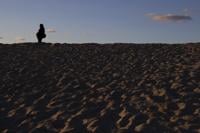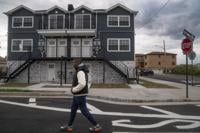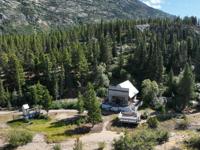NEW YORK (AP) — Even before Superstorm Sandy's floodwaters surged over New York City’s Rockaway Peninsula, there was an air of decay in Edgemere, a far-flung seaside neighborhood long pockmarked with boarded-up homes and vacant lots with waist-high weeds.
When the water receded, even more of Edgemere’s homes lay in ruin. But there was hope, too, that in the rebuilding effort the predominantly Black neighborhood would finally get the boost it needed to recover from decades of neglect. In the decade since , those hopes have been dashed.
There is little sign of the development promised along block after block of worn homes, some long unoccupied. Meanwhile, mostly white communities further west on the peninsula have flourished, with recovery funds bringing new housing, businesses, places to gather.
"They tell me that we’re one peninsula — no, we’re not. It’s a tale of two peninsulas,” said Edgemere resident Sonia Moise, whose home filled with seawater during Sandy, her car carried off by the tide.
“You go west, what do they have? They have a skatepark. They have a dog park. They have concession stands,” Moise said. “What do we have? We have homeless shelters. We have hotels that house homeless people.”
When Sandy hit the northeastern U.S. coastline on Oct. 29, 2012, the storm did not discriminate as it caused about $65 billion in damage — much of it in New York and New Jersey. Luxurious vacation homes on the Jersey Shore were torn apart; small homes in working-class sections of Staten Island were submerged up to their eaves.
But the rebuilding effort has been anything but equal. The woes in Edgemere are a case study in disparities that play out across the U.S. after natural disasters: The billions of dollars in recovery money that pour in make their way last to, and have their weakest impact in, communities of color. In New Orleans, the remarkable post-Katrina recovery made for where poor Black neighborhoods still struggle. In Florida, there are already grumblings along rows of crumpled mobile homes that help has been swiftest in resort beach communities in the wake of .
Public spending after disasters has led to increased inequality, said Junia Howell, a sociologist at the University of Illinois in Chicago who researches race, housing and disasters.
“Communities that are whiter and wealthier actually are not only recovering from disaster, but in many cases, they’re doing better,” Howell said. “What you’re doing is giving resources to those who already have the most resources and further leaving everyone else behind.”
The contrast is perhaps sharpest just west of Edgemere, in Arverne by the Sea. Like most of the Rockaway Peninsula — an 11-mile long sliver of barrier beaches that is home to around 124,000 people — both communities were almost entirely underwater after Sandy hit. But Edgemere residents say they watched Arverne and predominantly white communities get more help, and sooner.
Arverne already has a new grocery store and a Dunkin’ Donuts in a new commercial strip. And next door in Rockaway Beach is a new skatepark, rebuilt after Sandy tore apart the old one. Construction of a community amphitheater is in progress.
Neighbors admit it's not a perfect comparison. Some Arverne investment was underway before Sandy. Six years prior, a $1 billion development drew more white families to the neighborhood — which is still majority Black, though that number is dropping — and some of those 2,300 homes are being resold for as much as $1.7 million. The development was mostly unscathed by winds and flooding, prompting grumbling by Edgemere residents that their homes weren’t built to last.
What's clear, community board leader Moise and others say, is that Edgemere has never gotten its fair share.
“We have been fighting for years to get the same thing that the rest of our surrounding neighborhoods have gotten. We have been ignored,” Moise said.
Unlike Arverne, Edgemere has no coffee shops or concession stands. Along Beach Channel Drive, the main thoroughfare, there's a bodega and a Chinese takeout restaurant. Next door, a smoke shop is moving in. Up the street is a massive public housing project.
There's little sign here of the Rockaways' history as a beach resort community. The peninsula’s grand hotels didn’t survive into the automobile age. The 1950s brought urban renewal; officials tore down thousands of bungalows that were home to Black and Puerto Rican families, replacing some of that lost housing stock with high-rise housing projects while leaving other razed blocks to nature.
Edgemere and other communities on the eastern end of the Rockaways became dumping grounds for the city’s poorest residents, pushed out across a wide bay to the very end of the land, a 70-minute subway ride from Manhattan.
But just before Sandy, there was hope that things were getting better — even if neighboring communities were seeing faster progress. Edgemere was growing. People were moving in. City officials promised to build some 800 new homes to fill vacant lots.
Sandy brought those small signs of hope to a halt.
The city says it's working to bring change to Edgemere. Earlier this year, it finalized a development plan dubbed “Resilient Edgemere." Every member of the community board urged the City Council and mayor to reject it. But the community didn't have the political clout to stop it.
The plan includes vows of affordable housing near the beach, and high-rise apartments with 1,200 residential units above retail space. There's $14 million earmarked to buttress the shoreline with an elevated berm to protect Edgemere against 30 inches (76 centimeters) of sea level rise, and $2.3 million to upgrade sewage and drainage lines.
But residents worry the low-income units will add to the neighborhood’s longtime burden of housing the poor. More than a quarter of Edgemere residents live in poverty, the highest among Rockaways communities, according to a recent state report that highlighted longstanding inequalities in the area.
Those who have money spend it elsewhere because the community has few amenities.
And while the plan's shoreline work might be welcome news, many say it's another case of being last in line. In other places along the peninsula, sand dunes were beefed up quickly to keep tides from intruding as they did during Sandy. Edgemere’s beach restoration began only weeks ago.
Instead of the city's plan, community board members want more duplexes and townhomes to fit in with existing housing stock. They want a new school and grassy inland parks that could help absorb the next flood. They want amenities like the fully-stocked grocery stores found in neighboring, wealthier communities.
City officials insist they’ve made progress — they cite wetland restoration and the raising of 100-plus homes against flooding. Stretches of the wooden boardwalk have been replaced with a concrete promenade along the beach. Headquarters for a nature preserve is being built, but construction has limited community access to the boardwalk and beach.
Dexter Davis, a former NYC police officer whose Edgemere home was flooded with more than a yard (meter) of water during Sandy, says his community needs more than what's outlined so far.
“The things that they pump into the other communities around us are more positive. They give them more leisure things, better quality," Davis said. "Here, they do things — but it’s not up to the same par.”
Experts such as NYU sociologist Jacob Faber say it's not just natural disaster that has affected Edgemere and other poorer communities — it's the lingering impact of years of neglect.
“You have these geographically and socially and economically isolated communities that are in a position to just get hammered, over and over again,” Farber said.
__________
Associated Press writer Deepti Hajela contributed to this report.
Follow Bobby Caina Calvan on Twitter at














































